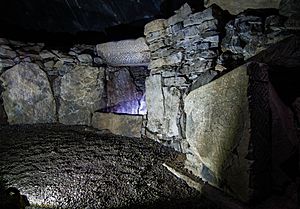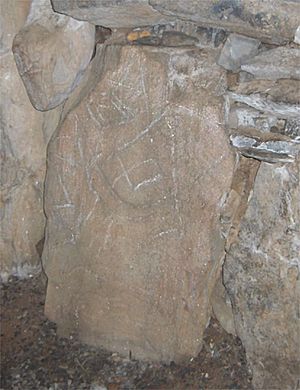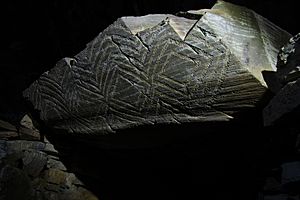Fourknocks Passage Tomb facts for kids
Quick facts for kids Fourknocks Passage Tomb |
|
|---|---|
| Native name Irish: Tuama Pasáiste na bhFuarchnoc |
|
 |
|
| Type | passage grave |
| Location | Fourknocks, Stamullen, County Meath, Ireland |
| Area | Delvin Valley |
| Elevation | 149 m (489 ft) |
| Built | c. 3000–2500 BC |
| Official name: Fourknocks Passage Tomb | |
| Reference no. | 472 |
| Lua error in Module:Location_map at line 420: attempt to index field 'wikibase' (a nil value). | |
The Fourknocks Passage Tomb is an ancient burial site in County Meath, Ireland. It is a special type of tomb called a passage grave. This means it has a long, narrow entrance passage leading to a main burial chamber. Fourknocks is also a National Monument, which means it is protected by the Irish government because of its historical importance.
Contents
Where is Fourknocks Located?
This ancient tomb is found about 2.7 kilometers (1.7 miles) northwest of Naul. It sits on a hilltop, giving it a great view over the Delvin River valley. The name "Fourknocks" comes from an old Irish phrase. It likely means either "cold hill" or "bare hill," describing its exposed location.
A Glimpse into History: When Was Fourknocks Built?
The Fourknocks Passage Tomb is incredibly old! It was built a very long time ago, between 3000 and 2500 BC. That's over 4,500 years ago!
For many centuries, this important site was hidden and forgotten. It wasn't known to archaeologists until 1949. The story goes that a woman visiting the famous Newgrange tomb mentioned, "there are mounds like this on my uncle’s farm." This led experts to discover Fourknocks. It wasn't even marked on old maps!
Uncovering the Secrets of Fourknocks
The first major dig at Fourknocks happened between 1950 and 1952. An archaeologist named PJ Hartnett led this important work. During the excavation, they found many interesting things:
- Cists: These are small stone boxes, often used for burials.
- Grave Goods: These are items buried with people, like a special foot bowl and a carved pin made from antler.
- Urns: These pots contained the ashes of people who had been cremated (burned after death).
- Postholes: These are holes in the ground where wooden posts once stood.
Unlike some other passage tombs, experts don't think Fourknocks was covered with a huge pile of stones. Instead, a wooden pole might have held up a roof made of wood or animal skins. After the excavation, a concrete roof was added to the main chamber. This was done to protect the ancient site from weather and damage.
What Does Fourknocks Look Like Inside?
The Fourknocks Passage Tomb has a short passage that leads into a large, pear-shaped main chamber. This main chamber has three smaller rooms, or "recesses," branching off it. Imagine a central room with three little side rooms!
The original roof of the tomb was probably made of wood. It was likely supported by a central wooden pole, as suggested by the postholes found during the dig.
Amazing Stone Carvings
Inside the tomb, you can see some amazing ancient art. Two of the stone lintels (these are the horizontal stones above a doorway or opening) have special patterns. One has a chevron design, which looks like a V-shape repeated. Another has a lozenge design, which looks like diamond shapes. These carvings are very old and give us clues about the beliefs of the people who built the tomb.
Other Mounds Nearby
The Fourknocks area actually has more than just the main tomb. Two other mounds nearby were also explored. One of these smaller mounds was likely used as a place to cremate (burn) the bodies. The bones found in the main tomb might have been prepared here. This smaller mound was also used for later burials.





